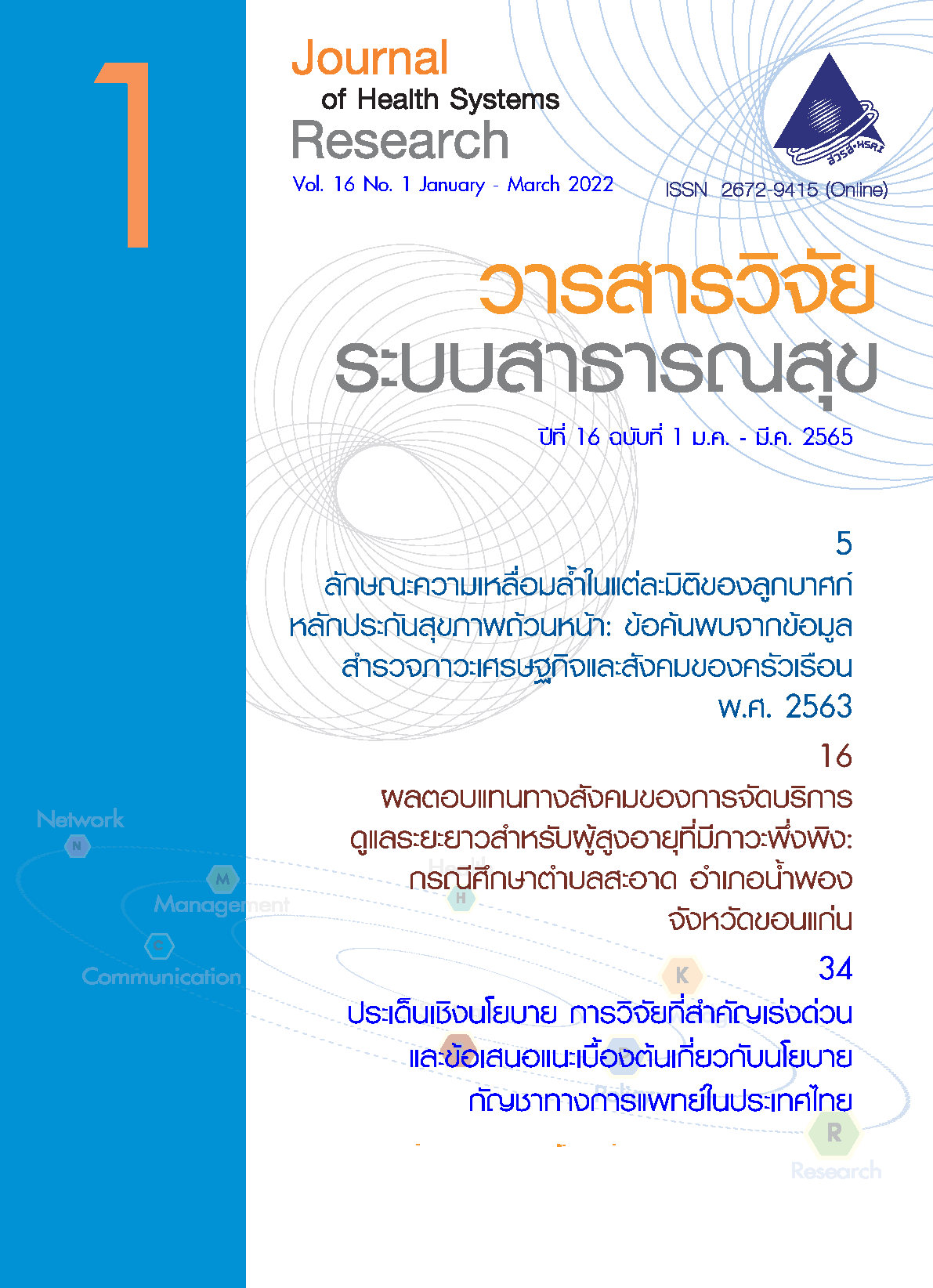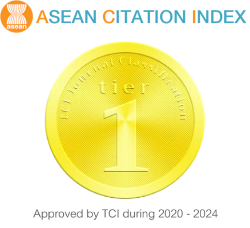การประเมินการส่งเสริมกิจกรรมทางกายในบริบทเมืองของไทยด้วยแผนปฏิบัติการส่งเสริมกิจกรรมทางกายโลก
คำสำคัญ:
กิจกรรมทางกาย, เมือง, ประเมิน, ชุมชน, ประเทศไทยบทคัดย่อ
กิจกรรมทางกายไม่เพียงพอเป็นปัจจัยเสี่ยงอันดับที่สี่ของการเสียชีวิตด้วยโรคไม่ติดต่อ เพื่อแก้ไขปัญหาการมีกิจกรรมทางกายไม่เพียงพอ จึงมีการคิดค้นและสนับสนุนให้มีการปฏิบัติในประเทศไทย ซึ่งได้เน้นความสำคัญของทั้งสังคม เพิ่มให้ครบทุกยุทธศาสตร์ในการสร้างสภาพแวดล้อมทางสังคม วัฒนธรรม เศรษฐกิจและสิ่งแวดล้อมทางกายภาพให้เอื้อต่อการมีกิจกรรมทางกาย การศึกษานี้มีวัตถุประสงค์เพื่อประเมินผลการดำเนินงานการส่งเสริมกิจกรรมทางกายในบริบทเมืองในพื้นที่ 12 เทศบาลด้วยสี่ยุทธศาสตร์ของแผนปฏิบัติการส่งเสริมกิจกรรมทางกายโลก ผลการศึกษาพบว่าทั้งสิบสองเทศบาลมีการนำอย่างน้อยหนึ่งยุทธศาสตร์ไปปฏิบัติในการส่งเสริมกิจกรรมทางกาย โดยในภาพรวมมีการบรรลุ 12 จาก 20 ยุทธศาสตร์ย่อยของแผนปฏิบัติการส่งเสริมกิจกรรมทางกายโลก ทั้งนี้ พบว่าเทศบาลนครมีคะแนนการบรรลุยุทธศาสตร์สูงที่สุด รองลงมาคือเทศบาลเมืองและเทศบาลตำบลตามลำดับ เมื่อจำแนกตามรายยุทธศาสตร์ พบว่าทั้งสิบสองเทศบาลมีการบรรลุยุทธศาสตร์ที่สาม: การส่งเสริมให้ประชาชนกระฉับกระเฉง และยุทธศาสตร์ที่หนึ่ง: การส่งเสริมให้สังคมกระฉับกระเฉง มากที่สุด การศึกษานี้ชี้ให้เห็นว่ายุทธศาสตร์ของแผนปฏิบัติการส่งเสริมกิจกรรมทางกายโลกมีความเหมาะสมและสอดคล้องกับการนำไปใช้ในบริบทไทย ทั้งนี้ แม้ว่าเทศบาลมีความเหมาะสมในการส่งเสริมกิจกรรมทางกาย แต่ก็ยังคงพบช่องว่างในการส่งเสริมในยุทธศาสตร์ที่สอง: การส่งเสริมสภาพแวดล้อมให้เอื้อกิจกรรมทางกาย และยุทธศาสตร์ที่สี่: การส่งเสริมระบบส่งเสริมกิจกรรมทางกาย โดยสรุป เทศบาลมีความเหมาะสมในการส่งเสริมกิจกรรมทางกายในบริบทเมืองร่วมกับภาคีอื่นทั้งภาครัฐและเอกชน และแผนปฏิบัติการส่งเสริมกิจกรรมทางกายโลกควรได้รับการพัฒนาตัวชี้วัดที่เหมาะสมในการประเมินกระบวนการและผลลัพธ์การส่งเสริมกิจกรรมทางกายเพื่อพัฒนานโยบายการส่งเสริมกิจกรรมทางกายต่อไป
เอกสารอ้างอิง
Lee IM, Shiroma EJ, Lobelo F, Puska P, Blair SN, Katzmarzyk PT, et al. Effect of physical inactivity on major non-communicable diseases worldwide: an analysis of burden of disease and life expectancy. Lancet. 2012;380(9838):219-29.
World Health Organization. Global health risks: mortality and burden of disease attributable to selected major risks. Geneva: World Health Organization; 2009.
World Health Organization. Global status report on non-communicable diseases 2014. Geneva: World Health Organization; 2014.
World Health Organization. Global health observatory data: prevalence of insufficient physical activity. Geneva: World Health Organization; 2016 [cited 2020 Apr 7]. Available from: https://www.who.int/gho/ncd/risk_factors/physical_activity_text/en/.
Katewongsa P, Widyastaria DA, Saonuam P, Haematulin N, Wongsingha N. The effects of COVID-19 pandemic on physical activity of the Thai population: evidence from Thailand’s surveillance on physical activity 2020. J Sport Health Sci. 2020.
Thailand Physical Activity Knowledge Development Center. Regenerating physical activity in Thailand after COVID-19 pandemic. Nakornpathom: Thailand Physical Activity Knowledge Development Center; 2020. (in Thai)
World Health Organization. Global action plan on physical activity 2018-2030. Geneva: World Health Organization; 2018.
Division of Physical Activity and Health, Department of Health, Ministry of Public Health. Thailand Physical Activity Strategy 2018-2030. Bangkok: NC Concept; 2018. (in Thai)
United Nations. World urbanization prospects: the 2018 revision. New York: United Nations, Department of Economic and Social Affairs, Population Division; 2018.
Liangruenrom N, Topothai T, Topothai C, Suriyawongpaisal W, Limwattananon S, Limwattananon C, et al. Do Thai people meet recommended physical activity level?: The 2015 national health and welfare survey. Journal of Health Systems Research. 2017;11(2):205-20. (in Thai)
Topothai T, Liangruenrom N, Topothai C, Suriyawongpaisal W, Limwattananon S, Limwattananon C, et al. How much of energy expenditure from physical activity and sedentary behavior of Thai adults: The 2015 national health and welfare survey. Journal of Health Systems Research. 2017;11(3):327-44. (in Thai)
Topothai T, Topothai C, Pongutta S, Suriyawongpaisal W, Chandrasiri O, Thamarangsi T. The daily energy expenditure of 4 domains of physical activity of Thai adults. Journal of Health Systems Research. 2015;9(2):168-80. (in Thai)
Tuangratananon T, Liangruenrom N, Topothai T, Topothai C, Limwattananon S, Limwattananon C, et al. Differences in physical activity levels between urban and rural adults in Thailand: findings from the 2015 national health and welfare survey. Journal of Health Systems Research. 2018;12(1):27-41. (in Thai)
Tuangratananon T, Topothai T, Khamput T, Saengruang N, Kosiyaporn H, Kulthanmanusorn A, et al. Public policy and social determinants of health management at three levels of municipalities in Thailand. Journal of Health Systems Research. 2018;12(3):384-403. (in Thai)
Royal Thai Government Gazette. Determining plans and process of decentralization to local government organization act B.E. 2542 (1999). Bangkok: Royal Cabinet; 1999. (in Thai)
Khamput T, Patsorn K, Thongbo T, Seunglee S, Keryai T, Sangsamritpol W, et al. Administration of physical activity promotion by twelve local administrative organizations in Thailand. Journal of Health Systems Research. 2019;13(1):63-89. (in Thai)
Division of Physical Activity and Health, Department of Health, Ministry of Public Health. 12 local authority models on physical activity promotion. Nonthaburi: Informan Teem Computer; 2018.
Division of Physical Activity and Health, Department of Health, Ministry of Public Health. Recommendation on physical activity promotion administration by local authorities. Nonthaburi: Informan Teem Computer; 2018.
Royal Thai Government Gazette. Public Health Ministerial Regulations 2009. Bangkok: Royal Thai Government Gazette; 2009. Available from: http://www.oic.go.th/FILEWEB/CABIN-FOCENTER17/DRAWER002/GENERAL/DATA0000/00000810.PDF. (in Thai)
Giles-Corti B, Vernez-Moudon A, Reis R, Turrell G, Dannenberg AL, Badland H, et al. City planning and population health: a global challenge. The Lancet. 2016;388(10062):2912-24.
Gotschi T, de Nazelle A, Brand C, Gerike R, Consortium P. Towards a comprehensive conceptual framework of active travel behavior: a review and synthesis of published frameworks. Curr Environ Health Rep. 2017;4(3):286-95.
Kim EJ, Kim J, Kim H. Does environmental walkability matter? The role of walkable environment in active commuting. Int J Environ Res Public Health. 2020;17(4):1261.
Audrey S, Fisher H, Cooper A, Gaunt D, Metcalfe C, Garfield K, et al. Public health research. A workplace-based intervention to increase levels of daily physical activity: the travel to work cluster RCT. Southampton (UK): NIHR Journals Library; 2019.
Gelius P, Messing S, Goodwin L, Schow D, Abu-Omar K. What are effective policies for promoting physical activity? A systematic review of reviews. Prev Med Rep. 2020;18:101095.
Topothai T, Topothai C, Suphanchaimat R, Chandrasiri O, Sukaew T, Putthasri W, et al. The promotion of walking and biking for transportation, and public transport using: a case study in four communities in Thailand. Nonthaburi: International Health Policy Program; 2020.
Division of Physical Activity and Health, Department of Health, Ministry of Public Health. Thailand action plan on physical activity 2018-2020. Bangkok: NC Concept; 2018. (in Thai)
Topothai T, Piyathawornanan C, Asawutmangkul U. Lessons learnt from developing and implementing the national steps challenge in Thailand. Journal of Health Systems Research. 2020;14(4):478-88. (in Thai)
Topothai T, Suphanchaimat R, Tangcharoensathien V, Putthasri W, Sukaew T, Asawutmangkul U, et al. Daily step counts from the first Thailand national steps challenge in 2020: a cross-sectional study. Int J Environ Res Public Health. 2020;17(22):8433.
WHO Regional Office for Europe. Healthy cities around the world. An overview of the healthy cities movement in the six WHO regions. Copenhagen: WHO Regional Office for Europe; 2003 [cited 2021 Jan 7]. Available from: https://www.euro.who.int/__data/assets/pdf_file/0015/101526/healthycityworld.pdf.
WHO Regional Office for Europe. Promoting physical activity and active living in urban environments: the role of local governments. Copenhagen: WHO Regional Office for Europe; 2006.
WHO Regional Office for Europe. A healthy city is an active city: a physical activity planning guide. Copenhagen: WHO Regional Office for Europe; 2008.
WHO Regional Office for Europe. Healthy cities: promoting health and equity – evidence for local policy and practice. Summary evaluation of Phase V (2009-2013) of the WHO European Healthy Cities Network. Copenhagen: WHO Regional Office for Europe; 2014.
WHO Regional Office for Europe. Health-enhancing physical activity (HEPA) policy audit tool. Copenhagen: WHO Regional Office for Europe; 2015.
Topothai T, Topothai C, Suphanchaimat R, Chandrasiri O, Sukaew T, Putthasri W, et al. Physical activity, carbon dioxide emission and cost of transport: a case study of three communities in Thailand. Journal of Health Systems Research. 2020;14(4):458-77.
ดาวน์โหลด
เผยแพร่แล้ว
รูปแบบการอ้างอิง
ฉบับ
ประเภทบทความ
สัญญาอนุญาต

อนุญาตภายใต้เงื่อนไข Creative Commons Attribution-NonCommercial-NoDerivatives 4.0 International License.
วารสารวิจัยระบบสาธารณสุขอยู่ภายใต้การอนุญาต Creative Commons Attribution-NonCommercial-NoDerivatives 4.0 International (CC BY-NC-ND 4.0) เว้นแต่จะระบุไว้เป็นอย่างอื่น




